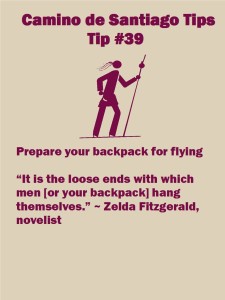 Congratulations! You have successfully culled down all the items you want to carry on your Camino. You’ve decided where to stow each essential item, making use of all inside and outside pockets and straps. The bag is balanced and comfortable for walking. All you have to do is get yourself, and your pack, to the starting point.
Congratulations! You have successfully culled down all the items you want to carry on your Camino. You’ve decided where to stow each essential item, making use of all inside and outside pockets and straps. The bag is balanced and comfortable for walking. All you have to do is get yourself, and your pack, to the starting point.
When flying, consider the size, weight, and liquid restrictions.
Checked with your airline for specific baggage rules. For most airlines:
- Size: The maximum size for a carry-on bag for an international flight is 45 in/115 cm (carry-on). It can be no larger than 22 in/56 cm long, 14 in/36 cm wide, and 9 in/23 cm deep, including handles and wheels; the carry-on must fit in the overhead compartment, in the space below the seat, or be checked-in. Most 25-liter backpacks comply with these dimensions.
- Weight: Since airlines vary on weight limits for carry-ons, check your airline for their specific limitations. In my research, the weight limit ranged from 12 to 40 lbs (5 to 15 kg).
- Liquid: Per the Transportation Security Administration (TSA) you can transport your personal hygiene in a container that is 3 ounces or less. Store all of these containers in a 1-quart size clear, plastic zip-lock bag. Don’t take your own water, juice, or soda on board; liquids cannot be carried beyond the boarding gate.
- Other restrictions. Depending on the airline you may not be able to carry the following items onto the plane: Camping/Outdoor Equipment (containing camp stoves with the residue of flammable liquid, camp fuel cylinders, strike-anywhere matches, insect sprays, propane heaters, etc.); sharp objects (knives, cutting instruments – including carpet knives, box cutters, folding or retractable blades, ice picks, straight razors, metal scissors with a cutting edge of more than four inches, pliers larger than seven inches). Gel shoe inserts are also considered a no-no by the TSA. Hiking poles are not spelled out on the TSA restriction list, so I would contact the airlines to see if they permit them in carry-on or not.
- Permitted items: Lithium batteries (with the terminals covered/insulated, or in the original packaging) and matches/lighters (one book of safety matches or one common lighter)
- Additional items allowed above and beyond the restrictions listed above may include Outerwear such as coats/wraps/hats; book or newspaper; a small bag of food to eat on the flight – no liquids; pillow or blanket.
Preparing the bag
Since your “mochila” (backpack) has straps that can entangle in machinery, it is important not to leave loose ends.
- Identify the bag. Place a name tag both inside and outside.
- Pack for accessibility. You will have to show your travel documents at the ticket counter and at the boarding gates at the airport. Make sure your passport, driver’s license, boarding pass, and other documents pertaining to your trip are easily attainable. I found carrying a belly bag helpful at the airport and on the Camino. If you are carrying electronics, pack these towards the top to quicken going through security.
- Tie up all the loose ends. Tighten straps. Make sure that items won’t fall out of the outer pockets. I use Velcro tie wraps to secure straps and pockets; once on the Camino, I use the tie wraps to identify hiking poles or to hang up clothes in the shower stalls.
- If your backpack is too large or bulky with shoes and other things attached to it, prepare it for check-in. Attach your poles to the bag. Secure everything as in step three. You can plastic wrap the bag at the airport (for a fee) or place it in a durable plastic bag. Check with the airlines to see if they offer a complimentary plastic bag. An alternative is to place the backpack in an old suitcase that you can discard at the destination.